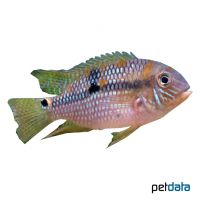Yellow Acara (Aequidens metae)
| Yellow Acara Aequidens metae | |
|---|---|
| Name | Yellow Acara |
| Name Lat. | Aequidens metae |
| Family | Cichlids |
| Family lat. | Cichlidae |
| Order | Cichlids |
| Order lat. | Cichliformes |
| Origin | Colombia |
| Habitat | Streams |
| Diet | Carnivore |
| pH | 6.0-7.0 |
| Behavior | Peaceful |
| Keeping | Pair |
| Care Level | Moderate |
| Reproduction | Substrate spawner |
| Breeding | Moderately difficult |
| Life Span | 8-12 years |
| Protection | No |
| Metric Units | |
| Size | 12 cm |
| Temperature | 24-28 °C |
| Hardness | 1-15 °dH |
| Aquarium | 120 cm / 240 l |
| US Units | |
| Size | 4.7" |
| Temperature | 75-82 °F |
| Hardness | 18-267 ppm |
| Aquarium | 65 gal |
Distribution and habitat
The distribution area of the Meta cichlids is the catchment area of the upper Rio Meta in Colombia. They live in slow-flowing streams and small rivers as well as in floodplains with trees and roots partly protruding into the water
Maintenance
The aquarium should have a robust border planting, with many hiding places (stones, roots), and offer free swimming space. A substrate of sand or fine gravel covered with some foliage (e.g. sea almond leaves) and slightly subdued light (floating plants) is ideal.
No ammonia, ammonium and nitrite should be detectable in the water, and the nitrate value should not exceed 100 mg/l. To ensure the water quality and oxygen content, a filter and heater adapted to the aquarium size is required, as well as lighting for the species-appropriate day-night rhythm of the animals.
Diet
They are unproblematic in feeding. The food supply consists of live food, such as daphnia, artemia, mysis, tubifex and red mosquito larvae, which is also accepted without problems in frozen form, supplemented with commercially available, frozen special food mixtures. High-quality flake and granulated food for cichlids is also readily eaten.
Only as much should be fed as is eaten immediately (in a maximum of 10 minutes). Regular and varied feeding promotes health and increases resistance
Behaviour and compatibility
They should be kept in pairs. During the spawning season these relatively peaceful cichlids behave very territorial, therefore keeping several pairs is only recommended in a larger and richly structured tank. They can be socialized well with other large fish, but consistently defend their territory.
Basically, only compatible fish species with similar demands on water conditions and water temperature should be socialized.
Sex dimorphism
The sex can hardly be distinguished in juvenile fish. Males grow slightly larger and their dorsal fin is extended longer than females, which are slightly rounder during spawning
Reproduction and breeding
They spawn on shallow stones or roots (open brooders). Both parents engage in intensive brood care (parental family) and defend the territory. After about 2 days the fry hatch and swim freely after about 6 days. The school of young fish is protected by the parents for some time and led to the feeding places in the aquarium before the brood care ends.
Fry must be fed several times a day with special rearing food. In community tanks breeding is hardly possible, because the young fish are easy prey.
Important
The well-being of the fish should be checked regularly. The temperature should be checked daily, the pH, hardness and nitrate value at least every 14 days. A regular partial water change is recommended, even if the pollutant load has not yet reached the upper limit. Sudden changes in water quality should be avoided. Newly introduced fish must be accustomed slowly to the water in the aquarium
Further literature can be found in your pet store.
References
Text: Werner Winter; Image: petdata
Source: BMELV (1998): Tierschutzgutachten - Haltung von Zierfischen (Süßwasser); RIEHL & BAENSCH (2004): Aquarien Atlas Bd. 3, Mergus Verlag; ENGELMANN (2005): Zootierhaltung - Tiere in menschlicher Obhut: Fische, Verlag Harri Deutsch
- Gemäß § 21 Abs. 5 Tierschutzgesetz idgF
